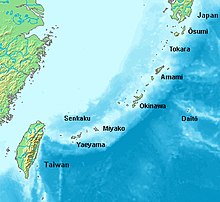
Back Eilandboog Afrikaans قوس الجزيرة Arabic Arcu insular AST Adalar qövsü Azerbaijani Островна дъга Bulgarian दीप चाप Bihari Arc insular Catalan Ostrovní oblouk Czech Inselbogen German Νησιωτικό τόξο Greek
Island arcs are long chains of active volcanoes with intense seismic activity found along convergent tectonic plate boundaries. Most island arcs originate on oceanic crust and have resulted from the descent of the lithosphere into the mantle along the subduction zone. They are the principal way by which continental growth is achieved.[1]

Island arcs can either be active or inactive based on their seismicity and presence of volcanoes. Active arcs are ridges of recent volcanoes with an associated deep seismic zone. They also possess a distinct curved form, a chain of active or recently extinct volcanoes, a deep-sea trench, and a large negative Bouguer anomaly on the convex side of the volcanic arc. The small positive gravity anomaly associated with volcanic arcs has been interpreted by many authors as due to the presence of dense volcanic rocks beneath the arc. Inactive arcs are a chain of islands which contains older volcanic and volcaniclastic rocks.[2]
The curved shape of many volcanic chains and the angle of the descending lithosphere are related.[3] If the oceanic part of the plate is represented by the ocean floor on the convex side of the arc, and if the zone of flexing occurs beneath the submarine trench, then the deflected part of the plate coincides approximately with the Benioff zone beneath most arcs.
- ^ Taylor, S. R. (1967). "The origin and growth of continents". Tectonophysics. 4 (1): 17–34. Bibcode:1967Tectp...4...17T. doi:10.1016/0040-1951(67)90056-x. ISSN 0040-1951.
- ^ Mitchell, Andrew H.; Reading, Harold G. (1971). "Evolution of Island Arcs". The Journal of Geology. 79 (3): 253–284. Bibcode:1971JG.....79..253M. doi:10.1086/627627. ISSN 0022-1376. S2CID 129378943.
- ^ FRANK, F. C. (1968). "Curvature of Island Arcs". Nature. 220 (5165): 363. Bibcode:1968Natur.220..363F. doi:10.1038/220363a0. ISSN 0028-0836.
© MMXXIII Rich X Search. We shall prevail. All rights reserved. Rich X Search